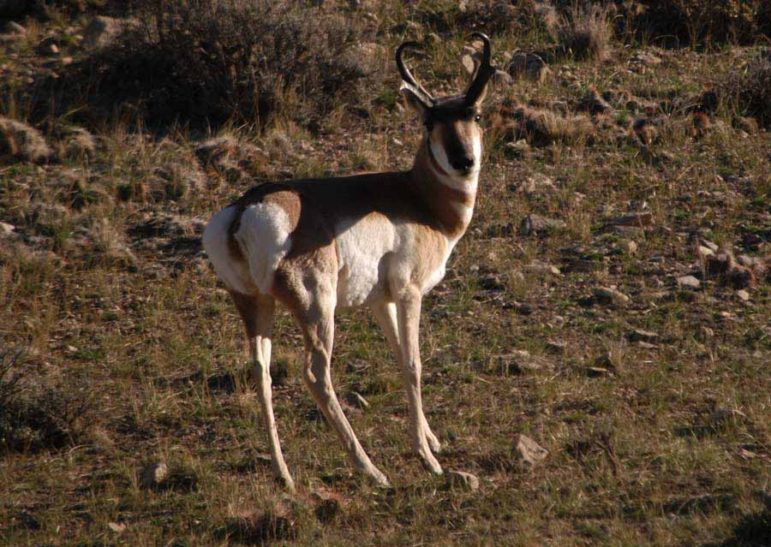
Ruffin Prevost/Yellowstone Gate
A pronghorn casts a watchful gaze toward a rural road along the Buffalo Bill Reservoir between Cody, Wyo. and Yellowstone National Park.
Pronghorn moving to and from the southern end of Grand Teton National Park appear to be adapting well to wildlife overpasses designed to alleviate a dangerous and long-standing bottleneck in their lengthy seasonal migrations.
Sometimes referred to as pronghorn antelope, the swift and elusive animals have long been hampered by a difficult highway crossing at Trapper’s Point, near Pinedale, Wyo., along part of their migration route that spans more than 100 miles.
But scientists with the Wildlife Conservation Society observing the fall pronghorn migration this year have seen the animals successfully using new overpasses and corridors, according to a statement released by the group.
Now in its second year of use by wildlife, the Trapper’s Point overpass was built to make it safer for the cautious pronghorn to cross busy U.S. Highway 191, where vehicle collisions had previously taken a grim toll on their spring and fall migrations.
Between 300-400 antelope travel up to 120 miles twice each year, moving from summer grounds along the Snake River in Grand Teton to winter range in the Upper Green River Basin.
Researchers found the pronghorn more at ease this fall in making the trip across the Trapper’s Point overpass and at other spots in a corridor of crossings designed to ease their travel.
“While it was great to see pronghorn first using the overpass last year, it was clear that the fences and structures were confusing to them,” said WCS Northern Rockies Program Coordinator Jeff Burrell.
“This year, groups numbering from 100 to 200 moved along a new route directly to, and over, the overpass with no delays,” Burrell said.
The overpass at Trapper’s Point is one of eight special wildlife passages constructed by the Wyoming Department of Transportation along a 13-mile stretch of highway. Sections of eight-foot high barrier fencing were placed along the highway to channel animals to the crossing points.
Two overpasses and six underpasses have been built, and accommodate pronghorn, mule deer, moose, elk and other wildlife, along with seasonal livestock drives.
The so-called “Pronghorn Passage” has attracted widespread attention as an example of the need to protect wildlife migration corridors as development continues to encroach on ancient routes used by a wide range of animals.
Researchers used GPS tracking collars to collect information over the course of five years on the location and timing of pronghorn movements and impediments to migration such as fences, roadways, pipelines and other development infrastructure.
The Pronghorn Passage is a 6,000-year-old route that is one of the longest land migrations in North America.
Pronghorn are the fastest land animals on the continent, and numbered an estimated 35 million in the early 19th century. Today, about 700,000 remain, with more than half of those living in Wyoming. The animals migrate to find food, mating opportunities and suitable habitat.
Wyoming Game and Fish director Scott Talbott said the overpass at Trapper’s Point and other safe passages like it were just the latest efforts in a 20-year WYDOT campaign to reduce big game mortality on the state’s highways.
“Although the project was designed to benefit both mule deer and pronghorn, the overpasses are especially important to pronghorn because they are some of the first structures ever built in North America to get this species across a major highway,” Talbott said in a statement released by WYDOT.
State officials say WYDOT crossing projects have resulted in the safe passage of approximately 30,000 big-game animals annually.
Contact Ruffin Prevost at 307-213-9818 or [email protected].

RE: Pronghorn migration video. Absolutely amazing photography! I’ve traveled to Yellowstone about five times, and love watching the pronghorn!